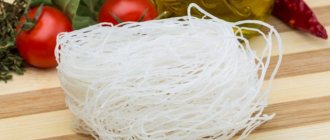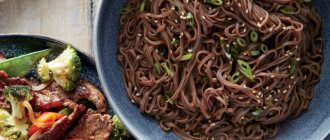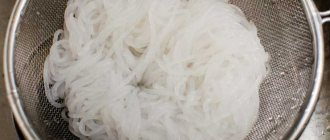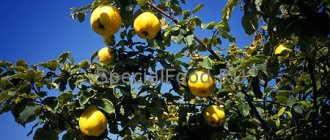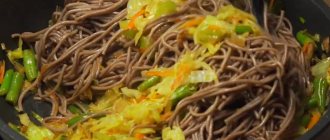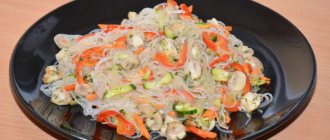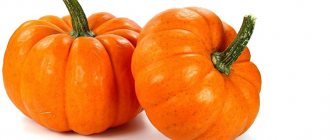China is traditionally considered the birthplace of rice noodles. However, experts claim that the Thais learned to make this product long before their neighbors. After all, light dishes based on it fit perfectly into the life concept of every Thai resident - “Sanuk and Sabai”: pleasure for the soul and body!
Rice noodles, unlike funchose or glass noodles, are prepared exclusively from rice flour and water. While the latter is a union of various types of starch (mung beans, yams, potato or corn) and water. The main value of rice noodles is the absence of gluten, so people suffering from partial or complete gluten intolerance can include them in their diet. It is slightly less caloric than wheat or buckwheat. Like the original product - rice - it contains essential acids, vitamins B and E. It is practically tasteless, and therefore goes well with any food, thanks to absorbing all the juices and aromas.
- Choose dry rice noodles without additives; they should contain only rice flour and water.
- Store the noodles in a ceramic or glass jar, tightly sealed, in a dark, dry place. Carefully remove the noodles from the container - they are very fragile. The main thing is to maintain its length, which can reach more than half a meter. After all, in the East they say: “The longer the noodles, the longer the life.”
- If you overcooked the noodles in boiling water and they softened, do not rush to get rid of the supposedly unsuitable product: everything can be fixed. The noodles can be dried. To do this, drain it in a colander, rinse with cold water, spread on a plate in one layer and leave for 30 minutes. You can also dry it in the microwave. To do this, place the noodles in a flat dish and place in the oven for 5–10 seconds, depending on its power.
Chemical composition of rice noodles
Rice noodles are pasta products made from rice flour. Due to its transparent structure, it is also called glass. In appearance, it is often confused with funchose. The difference is that the latter consists of bean starch.
This healthy product does not require boiling. Before eating, simply add hot water and leave for a few minutes. The main advantage of the product is its composition. It is gluten-free, fiber-free and salt-free. Due to this, the noodles are easily digestible and do not provoke an allergic reaction. The chemical composition of the product is represented by the following components:
We recommend reading: Gluten: what it is and why it is harmful, where it is found, symptoms of intolerance
- vitamins of groups E, PP and B;
- iron;
- copper;
- calcium;
- alimentary fiber;
- selenium;
- sodium;
- phosphorus;
- potassium;
- saturated fatty acids.
Rice noodles contain 7% protein
The mineral content ensures the strengthening of the musculoskeletal system. Vitamin B present in the composition has a positive effect on the condition of the skin. Iron helps prevent anemia. Saturated fatty acids provide the body with energy and promote the absorption of other components.
Attention! Rice noodles are white in color due to their starch content.
Mechanism of weight loss
If you replace some of the other side dishes with funchose, the daily calorie content will decrease. The dish has a neutral taste and goes well with other dietary products: meat, fish, seafood, vegetables or mushrooms. Slow carbohydrates take a long time to break down, providing a long-lasting feeling of fullness.
Useful for losing weight and cleansing the body, removing toxins that slow down metabolism. When internal organs are cleansed of harmful substances, metabolic processes accelerate.
What are the benefits of rice noodles?
Rice noodles are considered a rich source of many substances needed by the body. It contains 8 amino acids that take part in the most important life processes. It perfectly satisfies hunger, combining well with many foods.
Its beneficial properties include:
- fast saturation;
- normalization of nutrient balance;
- regulation of the gastrointestinal tract;
- replenishment of energy reserves;
- prevention of anemia;
- easy digestibility.
Experts recommend including rice noodles in the diet of people suffering from diseases of the cardiovascular system. It is especially useful for children and the elderly. Since the product does not contain fiber, it does not cause flatulence or stomach pain. After using it, there is no heaviness.
Due to the sodium and potassium content, rice flour vermicelli normalizes the water-salt balance, which helps get rid of edema. Due to the presence of magnesium in the composition, the product has a positive effect on the functioning of the cardiovascular system. The rich content of vitamin B ensures stabilization of the emotional state. Since noodles are complex carbohydrates, consuming them reduces the need for fats and glucose. This has a positive effect on your figure.
What is funchose
Thin rice noodles are increasingly used as a side dish during dieting. It has been proven that funchose for weight loss enhances the body's metabolic processes. This is due to the fact that the composition of glass noodles is about 20% resistant starch (which is not converted into glucose) remains in the intestines and becomes food for bacteria (fermentation process). By processing noodles, the body receives the necessary fatty acids, absorbs calcium and magnesium more easily, the level of glucose and cholesterol gradually decreases, and fat accumulations are “burned.”
Properties of glass noodles:
- vitamins B, D, macroelements;
- consists of complex carbohydrates that give a long-lasting feeling of fullness;
- amino acids contribute to the creation of new cells;
- no gluten;
- correct balance of BJU.
What is funchose made from?
Funchoza for weight loss is made from the starch of various East Asian plants, such as cassava, green mung beans, and quinoa. To reduce the cost of products, manufacturers are increasingly changing the composition of funchose: expensive starch from Chinese plants is replaced with cheap rice, potato or corn starch. Corn noodles can be distinguished only after cooking: they become white, and not transparent (crystal), like the original legume noodles. In addition, manufacturers of analogues add harmful zinc and aluminum to starch.
The benefits and harms of funchose
For people who want to lose weight and improve their health, rice noodles will become an indispensable assistant when losing weight, the main thing is to learn how to cook them correctly. The benefits and harms of funchose are described in the literature, but with proper preparation and selection of high-quality noodles, the negative consequences are leveled out, and nutritionists talk about its usefulness. You should not overeat if your body is weakened by chronic diseases. Since bean noodles are a side dish, pay close attention to the method of preparing them and the amount of spices, especially if you have problems with the gastrointestinal tract, or if you are cooking for a pregnant woman or nursing mother.
Beneficial properties of Chinese funchose for weight loss and PP:
- strengthening the nervous system;
- increasing skin elasticity, preserving its youth;
- decreased blood glucose in diabetes mellitus;
- reducing the risk of vascular diseases;
- improvement of the gastrointestinal tract, intestinal motility;
- strengthening bone tissue;
- maintains the water-salt balance of the body.
Calorie content
Starch noodles in dry form have a calorie content of 320 kcal/100 grams, in boiled form - 82 kcal/100 grams, with a low glycemic index (the rate of absorption of carbohydrates). Is funchose high in calories? Bean noodles themselves are a dietary product because they have minimal fat content. In rare cases, manufacturers add soy or buckwheat, but this has virtually no effect on calorie content or taste. Although the calorie content of funchose is high, it is recommended for overweight people, since it is made from bean flour, which does not harm the figure.
Harm of rice noodles
The benefits and harms of rice noodles are especially important to know when dieting. The product has many more positive properties. But there is an opinion that if consumed in excess, rice noodles can provoke the development of kidney and bladder cancer. This is due to the content of toxic substances in the product. The disadvantages include the bland taste of Asian vermicelli. To enrich it, fatty sauces and various flavor enhancers are often used in seasonings. They increase the calorie content of the dish and have a negative impact on health. To minimize the harm from a dish, it is enough to choose a safe dressing.
Is it possible to recover from funchose?
Do funchose make you fat? If you don’t eat a bucket of starchy noodles a day, you can’t get better from funchose. As with any other dish, eating a normal portion of noodles will not lead to weight gain. The main task of someone losing weight is to watch what they eat with Chinese vermicelli. If you indulge in fatty meats, baked goods and sweets, you will definitely not be able to lose weight. It is very healthy to eat starchy noodles with vegetables (marinated and stewed). You can use different oriental spices, this will add a pleasant aroma and unusualness to it. Ginger, sesame and honey go well with noodles.
How many calories are in rice noodles
The calorie content of rice noodles in finished form is 108 kcal per 100 g of product. A serving of a finished dish averages 200-250 g. Its calorie content does not exceed 300 kcal, which is considered below average for a side dish. The contents of the BZHU are as follows:
- proteins – 1.8 g;
- fats – 0.2 g;
- carbohydrates – 24 g.
Rice vermicelli dishes are recommended to be eaten with chopsticks
Funchoza for weight loss
Many people wonder whether it is possible to eat funchose on a diet when they find out the number of calories in a dish. Regular pasta is prohibited for consumption in most nutrition systems for losing weight, but the difference with glass noodles is their low-calorie content when cooked compared to the pasta products we are used to. According to nutritionists, when on a diet, funchose becomes an excellent substitute for almost any side dish. If you replace potato dishes with a portion of starchy noodles with dietary meat, the process of “burning” fat will begin to gain momentum.
Contraindications for rice noodles
Asian noodles made from rice flour are an easily digestible and nutritious product. But in some cases, its use should be abandoned. One of the main reasons is an allergic reaction. It occurs very rarely because the noodles do not contain gluten. Patients with diabetes need to be careful when introducing the product into their diet. Its glycemic index is 61, which is average.
It is equally important to pay attention to the quality of the product. When making counterfeits, bleaches containing lead and aluminum salts are used. They are necessary to give the product a suitable shade. These substances have a devastating effect on health. Therefore, rice noodles should only be purchased from trusted places.
Cooking rules
When cooking, you need to follow several rules so that the dish remains low-calorie, useful for losing weight. First, soak the noodles in water at room temperature for 5-10 minutes. This will speed up the cooking process and help preserve the beneficial properties of funchose. Then you should throw the product into water that has been previously brought to a boil and boil for 4 minutes. There is no need to salt the water. Then the water is drained. There is no need to rinse the noodles. When cooked correctly, the dish should become transparent.
Rules for eating rice noodles
Before preparing noodles, you need to study the recommendations indicated on the package. The product must be filled with hot water for 5-6 minutes. The process of liquid absorption is accompanied by an increase in mass. To avoid fibers sticking together, add 1-2 tbsp to the container. l. vegetable oil. In some cases, it is recommended to pre-soak the product in cold water. Initially, the noodles may be white. When ready, it becomes completely transparent.
Suitable dressing, vegetables or meat are added to the finished vermicelli. Most often it is seasoned with soy sauce or table vinegar. Seasonings are added as desired. At the end, the dish is sprinkled with chopped herbs or sesame seeds.
It is advisable to buy pasta that requires additional heat treatment. A finished dish containing them may include a lot of unnecessary additives. The nutritional value and benefits of the product are reduced as a result.
Comment! Tapioca is used to achieve the desired structure when making rice noodles.
Rice Noodle Recipes
Asparagus Casserole
For the casserole - 400 g of asparagus, 400 g of boiled rice noodles, 200 g of pollock fillet, optional carrots or bell pepper, and ground black peppercorns, 40 g of hard cheese and a tablespoon of soy sauce. Additionally - a baking dish.
Rice noodles are boiled separately. Rice noodles are placed on the bottom of the baking dish, followed by pollock fillet, vegetables, each layer is “laid” with a small portion of a mixture of cheese and soy sauce. The dish is baked at 180 degrees for 30-40 minutes and served hot.
Rice noodle salad
200 g each of shrimp and squid, 300 g of boiled rice noodles, any green leaf lettuce, such as romaine, or even kale, a tablespoon of sour cream, a teaspoon of creamy mustard or mustard powder, fresh cucumber.
Boil shrimp, squid and noodles and cool in a colander. Mix sour cream with mustard powder or mustard, chop fresh cucumber, chop or disassemble the salad by hand, mix all the ingredients of the dish in a deep salad bowl, and leave in the refrigerator for 20-30 minutes before serving.
Rice noodles with oriental beef
8 prunes, 1 carrot, red onion, a glass of vegetable broth, red pepper, ginger, cinnamon, sesame oil, sea salt, 300-400 g of glass or boiled rice noodles, 400 g of cauliflower, and 200 g of beef.
Chop all the vegetables and prunes, quickly fry in sesame oil along with spices, mix in a deep frying pan, and add beef. Add vegetable broth, reduce heat, close the lid and simmer over low heat until the meat is cooked. Add rice noodles, stir.
Rice noodle soup with squid
150 g raw peeled squid, rice noodles, 1 standard portion or 30-40 g dry, seaweed, white onion, carrots, miso soup base, sweet potato tuber.
Dissolve the base for miso soup in water, add shredded squid, sweet potato tuber, and cook until tender. Crush the seaweed and add it to the finished dish.
Spicy rice noodles with bean paste
For bean paste - a can of canned red beans, a white onion, black pepper on the tip of a knife, 1 cm of ginger root, and red pepper if desired, olive or sesame oil. For the main course, 4 servings of rice noodles, soy or teriyaki sauce, or sea salt.
Heat the oil over low heat in a deep frying pan, add spices and continue heating, add beans. Then grind the beans with spices into a paste in a blender. Cool. Boil the rice noodles, drain in a colander, then add soy sauce or salt to taste.
So, rice noodles are an excellent choice for those looking for an inexpensive and tasty side dish, they allow for experimentation in the kitchen and can be combined with many types of foods.
Applications of rice noodles
Rice noodles are one of the main ingredients in traditional Asian dishes. It can be used as a side dish or added to multi-component salads. It goes well with meat, fish, mushrooms and vegetables. The Japanese cook it together with radish, cucumber, carrots and seafood. In ancient times, samurai believed that rice noodles could increase life expectancy. The beneficial properties of the product were directly proportional to its length.
We recommend reading: Benefits of bell pepper, properties
Garlic, soy sauce, vinegar, red pepper, coriander and ginger powder are often used as seasonings.
We recommend reading: Chili peppers: benefits and harms, properties, how to eat them
In departments with Asian products you can buy a ready-made set of seasonings. Asian vermicelli is considered an excellent dietary product. It does not promote weight gain, while stabilizing metabolism. Due to its low calorie content, it can be eaten at any time of the day. The main advantage of the product is the quick satisfaction of hunger without the feeling of heaviness. In addition, it promotes the proper absorption of nutrients.
How to cook funchose
It's easy to prepare a delicious bean noodle dish at home. First you need to place it in warm water for 10 minutes, when it swells, put it in boiling unsalted water, boil for 3-5 minutes. Ready noodles can be added to soup, used as a side dish for fried chicken, turkey, shrimp, fish or pickled vegetables. You can make an unusual spicy Korean salad with soy sauce, carrots and sweet peppers. Cooking funchose will give you a subtle nutty aroma; serve it hot.
How to choose real Chinese noodles (fantasy in the original):
- study the composition;
- pay attention to the color - it may be slightly grayish, transparent, without a yellow tint;
- noodles are very fragile, regardless of the thickness of the threads;
- the threads are all separated, not stuck together;
- no smell;
- thread width up to 3 mm, length at least 50 cm.
Reviews
Alena, 28 years old, Saratov: “I decided to try the funchose diet because I love Asian cuisine. I wanted to lose some weight before my birthday. The advantage of the diet is the absence of hunger. In addition, there are many different foods in the diet, so weakness does not occur, hair does not fall out, and the skin does not become dry. I managed to lose 4.5 kg. Since I had a lot of energy left, I combined weight loss with training. I recommend".
Maria, 36 years old, Penza: “I eat funchose 1-2 times a week: I replaced the usual pasta with such noodles. The product satisfies well, even after a small portion you don’t want to eat for a long time. I season it with soy sauce: it turns out tasty and not too high in calories.”
Dmitry, 33 years old, Moscow: “My wife and I decided to lose a little weight for the beach season. First we tried a diet based on funchose. She managed without snacks; in between meals she ate apples or drank kefir. Then they replaced some of the side dishes with funchose. I lost 3 kg during the diet, then 8 kg in another 3 months. My wife managed to lose 5 kg during the diet, and in the next 3 months she lost another 13. Effective and tasty.”
Diet on funchose
The diet is designed for 5 days. During this time, if you follow a diet, you can lose from 3 to 5 kg of excess weight. It is necessary to consume at least 2 liters of clean water, green tea or herbal infusions daily. Nutritionists recommend repeating it no more than once every 3 months, so as not to harm your health.
Day 1. Breakfast: salad with funchose and fresh cucumber, a slice of rye bread. Lunch: boiled or baked lean fish with rice noodles. Dinner: fresh vegetable salad.
Day 2. Breakfast: natural grapefruit or orange juice, 2 kiwis. Lunch: boiled chicken fillet, funchose, carrot salad, dressed with a small amount of olive oil. Dinner: cottage cheese, a glass of low-fat kefir.
Day 3. Breakfast: 1–2 slices of hard cheese, funchose. Lunch: bean noodles, 2 soft-boiled eggs. Dinner: fresh cucumbers, water with lemon juice.
Day 4. Breakfast: 2 small oranges or grapefruit. Lunch: funchose with boiled fish, fish broth. Dinner: fresh, low-sugar fruit.
Day 5. Breakfast: funchose, pureed vegetable soup. Lunch: glass noodles, grilled chicken breast. Dinner: tea with a spoon of honey.
1 serving should not exceed 300 g. Among drinks, in addition to pure water, unsweetened green and herbal teas, natural juices, fruit drinks, compotes, coffee without sugar and milk are allowed. If following a diet is too difficult, snacks are allowed: unsweetened fresh fruits, fresh vegetables, natural yogurt or low-fat kefir.
For diseases of the gastrointestinal tract, during pregnancy, lactation, and in childhood, this weight loss system is not used.
Types of funchose
There are several varieties of dietary dishes, differing in the product from which they were made.
Rice
Rice noodles are sold in stores more often than other varieties. Made from fine flour. Wild brown rice is used for production, which allows you to preserve most of the nutrients.
Bean
This cooking option appeared earlier than the use of rice. Asian mung beans were used for the dish. The cost of bean noodles is higher, so sweet potatoes are often added to them, which makes the product cheaper.
Potato
Funchose is not prepared from pure potato starch. Manufacturers may, however, add potato starch to rice flour to reduce the cost of the product. This increases calorie content. The quality of the product also becomes worse, and some of the beneficial properties are lost. It is recommended to carefully study the composition and avoid products containing potato or corn starch.
